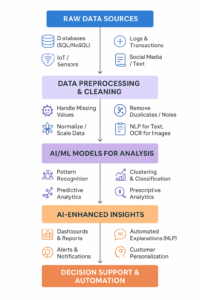How AI can help Data Analysis
🔹 How AI Helps in Data Analysis
1. Data Preprocessing & Cleaning
AI can automatically detect and handle missing values, duplicates, and outliers.
Natural Language Processing (NLP) can extract structured insights from unstructured data (emails, text logs, customer feedback).
Example: AI-powered tools can clean millions of messy health records faster than human analysts.
2. Pattern Recognition & Trend Detection
Machine Learning (ML) algorithms excel at recognizing hidden relationships in data that humans or classical methods may miss.
Time-series models can detect anomalies in financial transactions or server activity logs.
Example: Detecting fraud patterns in credit card transactions.
3. Predictive & Prescriptive Analytics
Predictive: AI can forecast outcomes based on historical data (e.g., sales forecasting, weather prediction).
Prescriptive: AI suggests actions to optimize results (e.g., recommending pricing strategies).
Example: Retailers use AI to predict customer demand and adjust inventory.
4. Automated Insights & Visualization
AI-driven tools can generate dashboards and even explain insights in plain language (e.g., “Sales dropped 15% due to lower foot traffic in urban stores”).
Reduces dependency on technical analysts for simple business queries.
5. Real-Time Data Analysis
With streaming AI models, businesses can analyze incoming data instantly.
Example: Monitoring IoT sensor data in smart factories to detect faults before breakdowns occur.
6. Handling Large & Complex Datasets
AI scales efficiently across massive datasets (petabytes in cloud systems).
Graph neural networks, deep learning, and clustering help make sense of high-dimensional, multimodal data (images + text + numbers).
Example: Analyzing global climate data from satellites, sensors, and simulations together.
7. Decision Support & Automation
AI models can serve as decision-support systems—suggesting diagnoses for doctors, investment strategies for bankers, or routes for logistics.
Automates repetitive analytics tasks, freeing analysts for higher-level strategic work.
🔹 Benefits of AI in Data Analysis
Speed & Efficiency → Processes huge datasets quickly.
Accuracy & Precision → Reduces human bias and error.
Scalability → Works well for growing volumes of data.
Actionable Insights → Moves from raw data → knowledge → recommendations.
✅ In short: AI makes data analysis faster, smarter, and more scalable, turning raw data into predictive and actionable insights that humans alone would struggle to extract.
